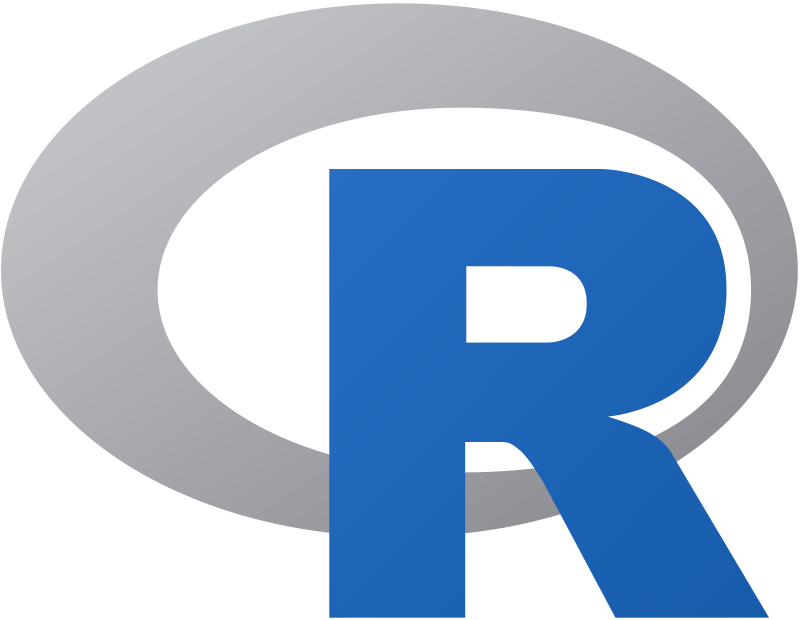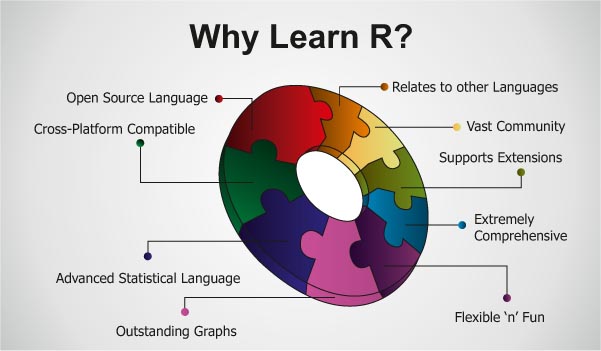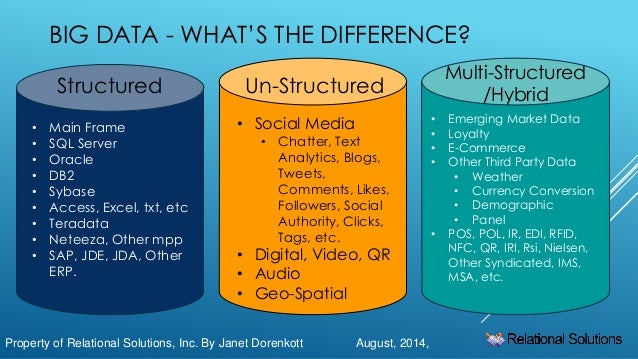
R is a programming language and software environment for statistical analysis, graphics representation and reporting. R was created by Ross Ihaka and Robert Gentleman at the University of Auckland, New Zealand, and is currently developed by the R Development Core Team. R is freely available under the GNU General Public License, and pre-compiled binary versions are provided for various operating systems like Linux, Windows and Mac. This programming language was named R, based on the first letter of first name of the two R authors (Robert Gentleman and Ross Ihaka), and partly a play on the name of the Bell Labs Language S.

Why use R for statistical computing and graphics?
- R is open source and free!
R is free to download as it is licensed under the terms of GNU General Public license.You can look at the source to see what’s happening under the hood. There’s more, most R packages are available under the same license so you can use them, even in commercial applications without having to call your lawyer. - R is popular – and increasing in popularity
IEEE publishes a list of the most popular programming languages each year. R was ranked 5th in 2016, up from 6th in 2015. It is a big deal for a domain-specific language like R to be more popular than a general purpose language like C#.This not only shows the increasing interest in R as a programming language, but also of the fields like Data Science and Machine Learning where R is commonly used. - R runs on all platforms
You can find distributions of R for all popular platforms – Windows, Linux and Mac.R code that you write on one platform can easily be ported to another without any issues. Cross-platform interoperability is an important feature to have in today’s computing world – even Microsoft is making its coveted .NET platform available on all platforms after realizing the benefits of technology that runs on all systems. - Learning R will increase your chances of getting a job
According to the Data Science Salary Survey conducted by O’Reilly Media in 2014, data scientists are paid a median of $98,000 worldwide. The figure is higher in the US – around $144,000.Of course, knowing how to write R programs won’t get you a job straight away, a data scientist has to juggle a lot of tools to do their work. Even if you are applying for a software developer position, R programming experience can make you stand out from the crowd. - R is being used by the biggest tech giants
Adoption by tech giants is always a sign of a programming language’s potential. Today’s companies don’t make their decisions on a whim. Every major decision has to be backed by concrete analysis of data.
Should you choose R?
Data scientist can use two excellent tools: R and Python. You may not have time to learn them both, especially if you get started to learn data science. Learning statistical modeling and algorithm is far more important than to learn a programming language. A programming language is a tool to compute and communicate your discovery. The most important task in data science is the way you deal with the data: import, clean, prep, feature engineering, feature selection. This should be your primary focus. If you are trying to learn R and Python at the same time without a solid background in statistics, its plain stupid. Data scientist are not programmers. Their job is to understand the data, manipulate it and expose the best approach.
Advantages and Disadvantages of R
There are various benefits of R as well as limitations of R language. Let us discuss them-
i. Advantages of R Programming
- R is the most comprehensive statistical analysis package as new technology and ideas often appear first in R.
- R is open-source software. Hence anyone can use and change it.
- R is an open source. We can run R anywhere and at any time, and even sell it under conditions of the license.
- R is good for GNU/Linux and Microsoft Windows. R is cross-platform which runs on many operating systems.
- In R, anyone is welcome to provide bug fixes, code enhancements, and new packages.
ii. Disadvantages of R Programming
- In R, quality of some packages is less than perfect.
- In R, no one to complain, if something doesn’t work.
- R is a software Application that many people devote their own time to developing.
- R commands give little thought to memory management, and so R can consume all available memory.

List of Big Companies using R
Google uses R in many ways. They use R to make online advertising more effective. They also use for economic forecasting and and Big-data statistical modeling.
Facebook uses R for Exploratory Data Analysis, Experimental Analysis, Big-Data Visualization, Human Resources, and user behaviour analysis related to status updates and profile pictures.
Twitter uses R for Data Visualization and Semantic Clustering. Twitter has created some super impressive projects using R. They also has created open-source packages for anomaly and breakout detection, which has helped improve their customer experience.
Airbnb
Most of the Airbnb data scientists use R and they also have an internal R package called Rbnb. They use R to scale data science. They use R to predict re-booking rates using past guest ratings and to automate guest or host matching.
Microsoft
Microsoft acquired Revolution Analytics in 2015 and they use R in many ways. Microsoft Azure uses R for understanding user behavior (how users configure monitoring platform), Visualizing infrastructure utilization data,
Abnormal login detection, Custom R packages to analyze monitoring data (time series anomaly detection), Forecasting hardware purchase requirements (forecast package). Also Xbox uses R for a great gaming experience. They also have packages RHadoop and ParallelR for Big Data.
Abnormal login detection, Custom R packages to analyze monitoring data (time series anomaly detection), Forecasting hardware purchase requirements (forecast package). Also Xbox uses R for a great gaming experience. They also have packages RHadoop and ParallelR for Big Data.
IBM
IBM Invests in R Programming Language for Data Science; joins R Consortium. The company has relied on R, among other data languages, to help create innovative solutions like IBM Watson, an open, cognitive computing technology platform that represents a new era in computing where systems understand the world like humans do: through senses, learning, and experience. As a member of the R Consortium, IBM will collaborate with the R user community and support the project’s mission to identify, develop and implement infrastructure projects that drive standards and best practices for R code.
New York Times
The New York Times uses R for interactive features (such as the Dialect Quiz and the Election Forecast); for data journalism (including these stories on NFL draft picks and wealth distribution in the USA); and for data visualization (such as in articles on the Facebook IPO and baseball pitching legends).
Novartis
R is well-known for its use in pre-clinical data analysis in drug research. And Swiss multinational pharmaceutical company Novartis Relies on analyzing clinical trial data for FDA submissions with R.
To Know which book to Refer go to-
https://www.r-bloggers.com/best-books-to-learn-r-programming/
REFERENCES-
https://www.r-bloggers.com/best-books-to-learn-r-programming/
REFERENCES-
https://www.tutorialspoint.com/r/index.htm
https://www.guru99.com/r-programming-introduction-basics.html
https://www.datamentor.io/r-programming/
https://data-flair.training/blogs/why-learn-r/
http://makemeanalyst.com/companies-using-r/
http://makemeanalyst.com/companies-using-r/





